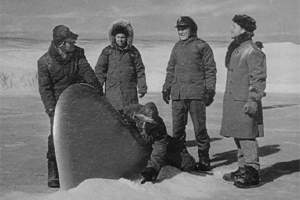 Scene from the 1951 film The Thing From Another WorldFor decades, if not longer, we Earthlings have been collectively waiting for that definitive day when we make First Contact with life from somewhere else in the universe, whether it's a Closer Encounter of the Third Kind kind of advent or the detection of a microbe on another world. Are we there yet? Well, no, not yet--but we may be a healthy step closer to that day now.
Scene from the 1951 film The Thing From Another WorldFor decades, if not longer, we Earthlings have been collectively waiting for that definitive day when we make First Contact with life from somewhere else in the universe, whether it's a Closer Encounter of the Third Kind kind of advent or the detection of a microbe on another world. Are we there yet? Well, no, not yet--but we may be a healthy step closer to that day now.
On Monday, November 30th, 2009, NASA/Johnson Space Center announced that a recent study strengthens the argument that chemical and structural features in a Martian meteorite—ALH84001—may be evidence of fossilized microbial life on Mars from the distant past. While not absolutely conclusive that the meteorite bears the remains of ancient Martian life, the results of the study show that alternate, non-biological explanations for some of the meteorite's properties are not consistent with new findings.
Meteorite ALH84001, discovered in Antarctica in 1984 and chemically identified as having originated on Mars, hit the news in 1996 when researchers hypothesized that microscopic features and chemical constituents in the rock could possibly be the fossilized remains of ancient Martian microbial life. The hypothesis was controversial among scientists, and alternate, non-biological processes were offered by opponents as possible explanations for the meteorite's features.
The recent reexamination of the meteorite was focused on one of the leading non-biological explanations for the existence of magnetite crystals in the sample. Magnetite is an iron-bearing, magnetic mineral that can be produced both biologically and through inorganic processes. Some forms of life on Earth—including microbes--produce magnetite crystals in their cells that help them orient to Earth's magnetic field.
The NASA/JSC team that performed the new analysis of ALH84001 concluded that new data on the magnetite crystals, obtained with more powerful analytic instrumentation than used in the 1996 study, are not consistent with the leading non-biological explanations. This, they argue, strengthens the biological explanation for the origin of the magnetite.
